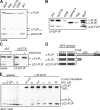The c-FLIP-NH2 terminus (p22-FLIP) induces NF-kappaB activation
- PMID: 16682493
- PMCID: PMC2121210
- DOI: 10.1084/jem.20051556
The c-FLIP-NH2 terminus (p22-FLIP) induces NF-kappaB activation
Abstract
c-FLIP proteins (isoforms: c-FLIP(L), c-FLIP(S), and c-FLIP(R)) play an essential role in the regulation of death receptor-induced apoptosis. Here, we demonstrate that the cytoplasmic NH2-terminal procaspase-8 cleavage product of c-FLIP (p22-FLIP) found in nonapoptotic malignant cells, primary T and B cells, and mature dendritic cells (DCs) strongly induces nuclear factor kappaB (NF-kappaB) activity by interacting with the IkappaB kinase (IKK) complex via the IKKgamma subunit. Thus, in addition to inhibiting apoptosis by binding to the death-inducing signaling complex, our data demonstrate a novel mechanism by which c-FLIP controls NF-kappaB activation and life/death decisions in lymphocytes and DCs.
Figures







References
-
- Golks, A., D. Brenner, C. Fritsch, P.H. Krammer, and I.N. Lavrik. 2005. c-FLIPR, a new regulator of death receptor-induced apoptosis. J. Biol. Chem. 280:14507–14513. - PubMed
-
- Krueger, A., I. Schmitz, S. Baumann, P.H. Krammer, and S. Kirchhoff. 2001. Cellular flice-inhibitory protein splice variants inhibit different steps of caspase-8 activation at the cd95 death-inducing signaling complex. J. Biol. Chem. 276:20633–20640. - PubMed
-
- Scaffidi, C., I. Schmitz, P.H. Krammer, and M.E. Peter. 1999. The role of c-FLIP in modulation of CD95-induced apoptosis. J. Biol. Chem. 274:1541–1548. - PubMed
-
- Thome, M., P. Schneider, K. Hofmann, H. Fickenscher, E. Meinl, F. Neipel, C. Mattmann, K. Burns, J.L. Bodmer, M. Schröter, et al. 1997. Viral FLICE-inhibitory proteins (FLIPs) prevent apoptosis induced by death receptors. Nature. 386:517–521. - PubMed
Publication types
MeSH terms
Substances
LinkOut - more resources
Full Text Sources
Other Literature Sources
Miscellaneous

